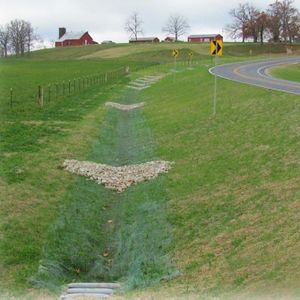
Pretreatment - Screening and straining devices, including forebays
Screening and straining devices trap trash and coarse debris using smaller apertures such as grates or screens. While many pretreatment devices utilize screening and straining in tandem with their main treatment process, the examples in this category are constrained to those that primarily remove larger particles and sediment by screening or straining. These devices are often visible from ground level as they generally sit above grade or slightly below grade before or just following inlets in order to protect the downstream drainage system/BMP from clogging. This table contains both proprietary and nonproprietary devices, with the proprietary systems often applying the same or similar mechanisms to the nonproprietary systems but with convenient and sometimes easier construction or ease of maintenance.
Contents
System design
Screening and straining devices can often be installed in parallel to accommodate larger drainage areas, but in general, each unit is intended for a small drainage area (< 1acre).
System and component sizing
Most important for the sizing is the anticipated frequency of operation and maintenance as well as the considerations of how well the device provides protection of downstream BMPs and receiving waters.
Links to tables with information on screening and straining devices
Below are links to several tables containing information on screening and straining devices. To see all tables on a single page, link here.
- Screening and straining devices - general information
- Screening and straining devices - system design information
- Screening and straining devices - system and component sizing
- Screening and straining devices - installation and maintenance recommendations
Related pages
- Pretreatment selection tool
- Overview and methods of pretreatment
- Overviews for different types of pretreatment practices
- Information for specific types of pretreatment practices
- Design, construction, operation and maintenance specifications for pretreatment vegetated filter strips
- Pretreatment - Hydrodynamic separation devices
- Pretreatment - Screening and straining devices, including forebays
- Pretreatment - Above ground and below grade storage and settling devices
- Pretreatment - Filtration devices and practices
- Pretreatment - Other pretreatment water quality devices and practices
- To see the above pages as a single page, link here
Pretreatment sizing for basins and filters strips
Guidance for managing sediment and wastes collected by pretreatment practices
Tables
- Pretreatment tables - link to tabled information for pretreatment practices
- Hydrodynamic separator tables
- Screening and straining devices tables
- Above ground and below grade storage and settling tables
- Filtration tables
- Other water quality devices tables
Other information and links
This page was last edited on 5 December 2022, at 23:40.

